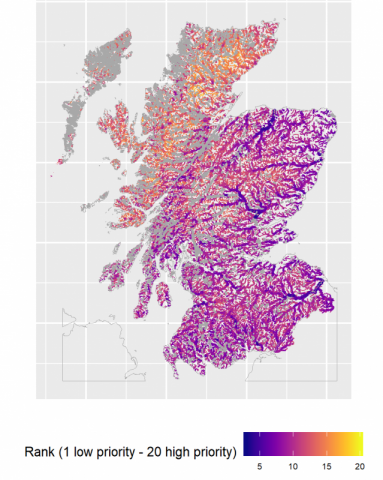Scotland River Temperature Monitoring Network (SRTMN) – Riparian Woodland Prioritisation Scores
Increasing river temperatures are a threat to many of Scotland's freshwater species which are often adapted to live in cool environments. This includes ecologically and economically important freshwater fish species such as Atlantic salmon and brown trout. Management of riparian woodland is proven to protect cold water habitats. However, Scotland has ca. 108,000 km of rivers, of which only ca. 35% are protected by any substantial tree cover. Furthermore, the creation of new riparian woodland can be costly and logistically challenging compared to other forms of large scale woodland creation. It is therefore important that riparian tree planting is prioritised to areas where it can have greatest benefits for river temperature, specifically, where rivers are (1) hottest , (2) most sensitive to climate change, and (3) can be effectively cooled by riparian woodland. These three individual criteria can be combined with an equal weight to provide a single riparian woodland prioritisation score that looks to maximise the benefits of riparian tree planting for protecting Scotland’s rivers from the adverse effects of climate change.
Given the variety of potential tree planting options (southerly banks, northerly banks, both banks) and the need to scale results both nationally and locally, the outputs are illustrated as six layers on Marine Scotland Maps NMPi:
- Nationally scaled tree planting prioritisation score where trees are planted on both banks
- Nationally scaled tree planting prioritisation score where trees are planted on only the most southerly bank
- Nationally scaled tree planting prioritisation score where trees are planted on only the most northerly bank
- Locally scaled tree planting prioritisation score where trees are planted on both banks
- Locally scaled tree planting prioritisation score where trees are planted on only the southerly bank
- Locally scaled tree planting prioritisation score where trees are planted on only the northerly bank
Riparian woodland prioritisation scores are on a scale of 1- 20, where 1 is low priority (low temperature, weak sensitivity to climate change and only a small reduction in temperature gained from planting trees) and 20 is high priority (high temperature, strong sensitivity to climate and a large expected reduction in temperature where trees are planted).
Details of the modelling work that produced these layers can be found in two associated peer-reviewed publications (see More Information below). Model outputs are presented on river line features derived from a Digital Rivers Network licensed from the Centre for Ecology and Hydrology (CEH).


